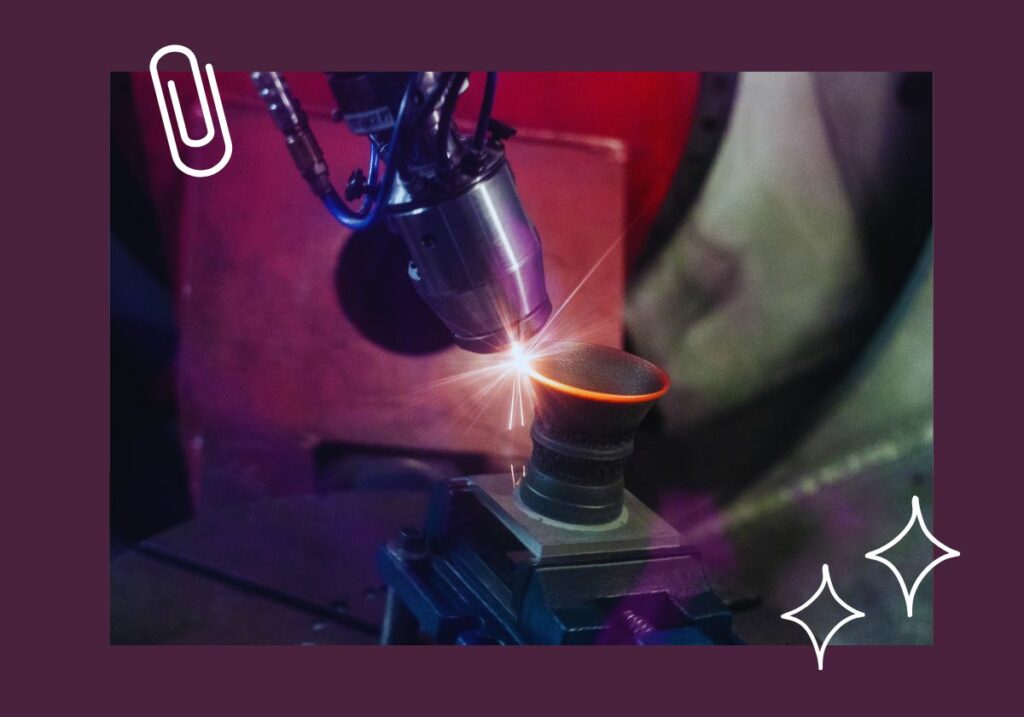Long confined to rapid prototyping, additive manufacturing is now establishing itself as a genuine lever for industrial transformation. By adding material layer by layer, this technology makes it possible to design complex, lightweight, customized parts… while shortening development cycles.
At DOUBLE CŒUR, we integrate this innovation into the heart of our industrial expertise to meet the challenges of performance and customized production.
What is additive manufacturing?
Additive manufacturing is a manufacturing process which, unlike traditional machining or casting methods, builds parts by progressively adding material, usually from a 3D file.
In particular, it differs from consumer 3D printing, which is often associated with plastics or prototyping. In an industrial context, we speak of metal additive manufacturing, as it uses metallic materials in powder or wire form to produce technical, durable and resistant parts. This technology offers unrivalled design freedom, while maintaining an excellent level of precision. It is particularly well-suited to the needs of customized production, component weight reduction or small and medium production runs.
How does metal additive manufacturing work?
The principle of layer-by-layer deposition
At the heart of the process, metal additive manufacturing is based on a simple but powerful principle: adding material instead of removing it. Starting from a digital 3D model, the machine creates the final part layer by layer, solidifying the metallic material as it goes. This controlled deposition is made possible by a high-precision laser source that heats and fuses the material locally, without mechanical contact. The result is complex, hollow or lightweight shapes that would be impossible to produce using conventional processes.
The materials used are generally :
- Fine metal powders (stainless steel, titanium, Inconel, aluminum, etc.)
- Metal wires deposited according to geometric requirements
This additive approach enables high precision to be achieved, while limiting material losses.
The main technologies used
Metal additive manufacturing uses several processes, which DOUBLE CŒUR masters according to the requirements of the project:
- LMD (Laser Metal Deposition): here, the material (powder or wire) is injected directly into the molten bath created by the laser. This technology is ideal for reloading existing parts, or manufacturing complex shapes on metal substrates.
- SLM / DMLS (Selective Laser Melting / Direct Metal Laser Sintering): the part is built on a bed of metal powder, fused point by point by the laser beam. This process is particularly well-suited to high-precision parts with a very fine finish.
Each of these processes offers specific advantages depending on materials, geometries and production rates. Our role at DOUBLE CŒUR is to guide you towards the most effective solution for your industrial objectives.
Why choose additive manufacturing in industry?
Technical and industrial advantages
Additive manufacturing is not just a technological innovation, it’s a real industrial opportunity. It overcomes the limits of traditional processes, offering unprecedented freedom of design and invaluable production agility in a highly demanding environment.
Key benefits include :
- The ability to create complex geometries (internal shapes, lightening, one-piece parts).
- Significantly reduced component weight without compromising strength
- Elimination of certain assembly steps, thanks to integrated part design
- On-demand production, limiting stocks and shortening lead times
- Optimized materials: only what is needed for the part is consumed
- Customization of parts, without the additional cost of specific tooling
These features make it a particularly attractive solution for technical, customized or high value-added production.
Examples of concrete applications
Metal additive manufacturing is now finding its place in many strategic sectors:
- Aerospace: lightweight components, complex heat exchangers, engine parts.
- Automotive: functional prototypes, performance parts, optimized body components
- Energy: turbines, high-temperature parts, maintenance components
These examples illustrate the versatility of this technology, which can be adapted to a wide range of environments while meeting the highest standards of reliability and performance.
DOUBLE COEUR, expert in metal additive manufacturing
At DOUBLE CŒUR, we see metal additive manufacturing as much more than just a technology: it’s an industrial solution that we master down to the smallest detail, from technical design right through to series production. Our expertise is based on in-depth knowledge of laser processes, and our ability to select the method best suited to your needs: whether to create complex parts, restore geometry by reloading, or produce high value-added technical batches.
We work with our customers on a co-engineering basis, integrating functional constraints, production requirements and performance objectives from the outset. Thanks to our flexible production resources, we are able to respond to both one-off requests and small industrial production runs.
FAQ on additive manufacturing
What’s the difference between 3D printing and additive manufacturing?
Additive manufacturing refers to industrial (often metallic) processes based on the addition of material, while 3D printing is broader and also includes plastic or consumer uses.
Can additive manufacturing be used to produce finished parts?
Yes, it produces functional, durable parts ready for use in industrial environments.
What materials can be used?
A wide range of metals can be used, including aluminum, stainless steel, titanium and Inconel, depending on the process and application.
